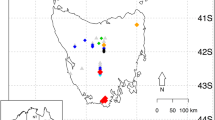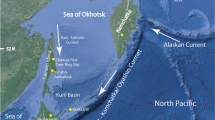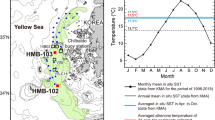Abstract
We describe an improved tree-ring reconstruction of mean warm-season (November–April) temperatures for Tasmania from Huon pine. This record extends back to 1600 BC and is based on a tree-ring chronology that was processed to retain as much low-frequency variance as possible. The resulting reconstruction explains 46.6% of the variance and verifies significantly when compared to withheld instrumental data. Cross-spectral analysis of actual and estimated temperatures over the 1886–1991 common period indicates that most of the unexplained variance is at periods < 12 years in length. At periods > 12 years, the squared coherency ranges between 0.6–0.8, and the cross-spectral gain indicates that the amplitude of the reconstruction is a nearly unbiased estimate of the true temperature amplitude. Therefore, this reconstruction should be especially useful for studying multi-decadal temperature variability in the Tasmanian sector of the Southern Hemisphere over the past 3592 years. To this end, we examined the time evolution of low-frequency temperature amplitude fluctuations and found evidence for a 35% amplitude reduction after AD 100 that persisted until about AD 1900. Since that time, the low-frequency temperature amplitude has systematically increased. We also show how this reconstruction is related to large-scale sea surface temperatures (SST) in the Indian Ocean and eastward to the dateline. Pointwise correlations between the Tasmanian record and SSTs reveal a relationship that extends across the southern Indian Ocean and towards the Arabian Sea. This pattern is largely determined by inter-decadal temperature variability, with correlations in this > 10-year bandwidth commonly exceeding 0.6 over most of the southern Indian and southwestern Pacific sectors. A rotated empirical orthogonal function analysis reveals that the pattern of pointwise correlations found between the temperature reconstruction and SSTs is largely explained by the linear combination of three orthogonal modes of SST variability.
Similar content being viewed by others
Author information
Authors and Affiliations
Additional information
Received: 12 January 1999 / Accepted: 31 July 1999
Rights and permissions
About this article
Cite this article
Cook, E., Buckley, B., D'Arrigo, R. et al. Warm-season temperatures since 1600 BC reconstructed from Tasmanian tree rings and their relationship to large-scale sea surface temperature anomalies. Climate Dynamics 16, 79–91 (2000). https://doi.org/10.1007/s003820050006
Issue Date:
DOI: https://doi.org/10.1007/s003820050006




